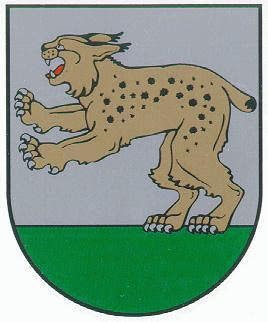 Alternate names: Raseiniai [Lith], Rasayn [Yid], Rossieny [Rus], Raseinen [Ger], Rosienie [Pol], Raseiņi [Latv], Rasein, Raseyn, Raseinai, Rasseyn, Resein, Rossein, Russian: Россиены. ראַסיין-Yiddish. 55°22' N, 23°07' E, 45 miles NW of Kaunas (Kovno), 40 miles SSW of Šiauliai (Shavl), in SE foothills of the Samogitians highland on the banks of the Dubiseh river, 3.1 mi N of the Kaunas-Klaipėda highway. Yizkor: Yahadut Lita (vol. 3) (Tel Aviv, 1967) and Lite (vol. 1) (New York, 1951). Dating from the 13th century and later with a population of 12,000 residents (second only to Kovno) but completion of the Libove-Romner railroad brought the new town of Shavl to prominence. The town was a Haskalah movement center. In 1842, the city had 7,455 inhabitants, the majority of whom were Jews. 1866 population was 10,579, of whom 8,290 were Jewish. 1897 district population (excluding the town) was 221,731, of whom about 17,000 were Jewish. Raseyn, lacking a railroad connection or highway, went downhill until just before WWI. During most of WWI, the German army occupied the town. Its mostly wooden houses, old and small, survived WWI battles fought eighty km from the town. After WWI, streets were paved and wide cement sidewalks and new houses were built. Although prior to 1914, two-thirds of the 6,000 residents were Jewish, afterward, the proportion reversed. The economy thrived during WWI, but returned to minimal afterward causing many to emigrate to America, Mexico, and South Africa. Shoemakers, tailors, carpenters and bricklayers from the Lithuanian villages settled in town leaving egg-exporters, lumber traders, and grain and flax merchants without income. An old-age home of the former Jewish community, a bikur kholim, and a library were created prior to WWI. In 1918, Raseiniai became a district capital of the Republic of Lithuania. By 1926, 2,226 Jews remained in Raseiniai and approximately 2,000 (40%) in 1939. During World War II, Raseiniai was ruined; about 90% of the buildings were destroyed. 254 Jews were murdered on July 29, 1941 in Raseiniai by a detachment of Einsatzkommando 3, assisted by a Lithuanian Kommando group. [March 2009]
Alternate names: Raseiniai [Lith], Rasayn [Yid], Rossieny [Rus], Raseinen [Ger], Rosienie [Pol], Raseiņi [Latv], Rasein, Raseyn, Raseinai, Rasseyn, Resein, Rossein, Russian: Россиены. ראַסיין-Yiddish. 55°22' N, 23°07' E, 45 miles NW of Kaunas (Kovno), 40 miles SSW of Šiauliai (Shavl), in SE foothills of the Samogitians highland on the banks of the Dubiseh river, 3.1 mi N of the Kaunas-Klaipėda highway. Yizkor: Yahadut Lita (vol. 3) (Tel Aviv, 1967) and Lite (vol. 1) (New York, 1951). Dating from the 13th century and later with a population of 12,000 residents (second only to Kovno) but completion of the Libove-Romner railroad brought the new town of Shavl to prominence. The town was a Haskalah movement center. In 1842, the city had 7,455 inhabitants, the majority of whom were Jews. 1866 population was 10,579, of whom 8,290 were Jewish. 1897 district population (excluding the town) was 221,731, of whom about 17,000 were Jewish. Raseyn, lacking a railroad connection or highway, went downhill until just before WWI. During most of WWI, the German army occupied the town. Its mostly wooden houses, old and small, survived WWI battles fought eighty km from the town. After WWI, streets were paved and wide cement sidewalks and new houses were built. Although prior to 1914, two-thirds of the 6,000 residents were Jewish, afterward, the proportion reversed. The economy thrived during WWI, but returned to minimal afterward causing many to emigrate to America, Mexico, and South Africa. Shoemakers, tailors, carpenters and bricklayers from the Lithuanian villages settled in town leaving egg-exporters, lumber traders, and grain and flax merchants without income. An old-age home of the former Jewish community, a bikur kholim, and a library were created prior to WWI. In 1918, Raseiniai became a district capital of the Republic of Lithuania. By 1926, 2,226 Jews remained in Raseiniai and approximately 2,000 (40%) in 1939. During World War II, Raseiniai was ruined; about 90% of the buildings were destroyed. 254 Jews were murdered on July 29, 1941 in Raseiniai by a detachment of Einsatzkommando 3, assisted by a Lithuanian Kommando group. [March 2009]
CEMETERY:
I visited the site of the former Jewish cemetery of Raseiniai on August 3, 1997 with guide Regina Kopilevich. The site, in the yard of a modern apartment building, is marked by a stone tablet on a wall that reads: "On this spot was a Jewish cemetery" in Yiddish and Lithuanian. Source: This email address is being protected from spambots. You need JavaScript enabled to view it., Brooklyn, NY 11201 [1997]
I was there in June 2007, took photographs, and saw a marker on a stone wall next to a apartment complex. This email address is being protected from spambots. You need JavaScript enabled to view it. [July 2007]
Giedrius Cyras Raseyn jewish cemetery and small sign via Lithuania Jewish Cemetery Project [Aug 2015] 
